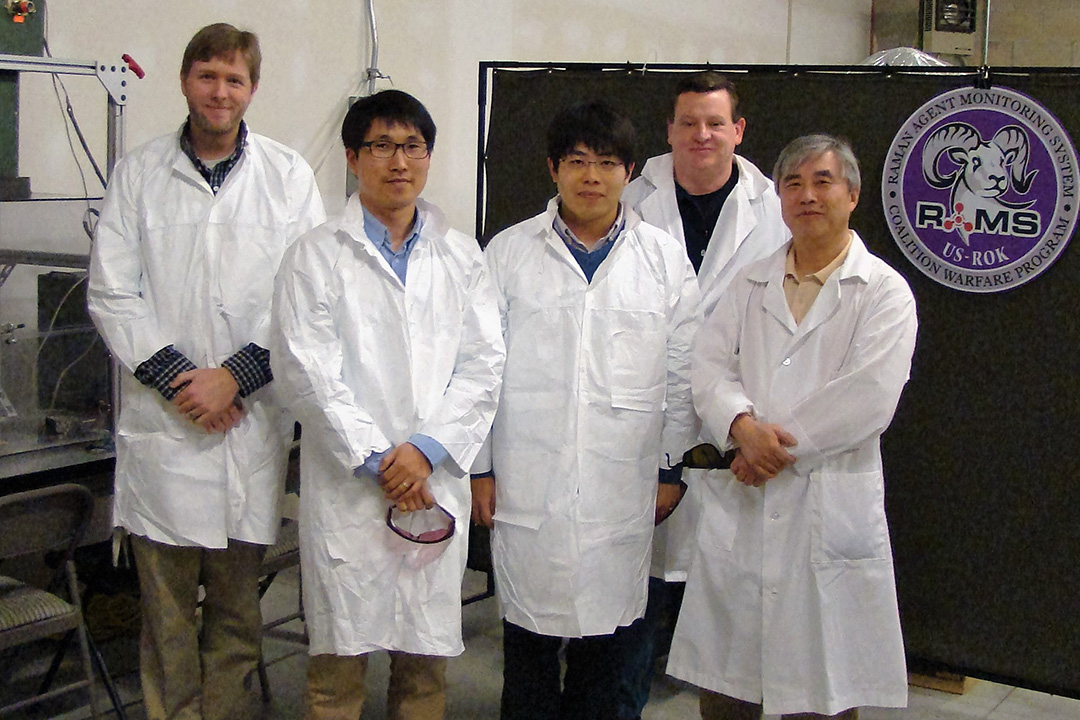// NEWS RELEASE
Prototype Laser Detection Device Moving Forward Thanks to International Collaboration
CCDC Chemical Biological Center Public Affairs | January 4th, 2019
Prototype Laser Detection Device Moving Forward Thanks to International Collaboration
DEVCOM CBC Public AffairsJanuary 4th, 2019

Through an international partnership with South Korea, RDECOM ECBC scientists are developing an on-the-move agent detection capability for vehicles.
Through an international partnership with South Korea, RDECOM ECBC scientists are developing a vehicle-mounted laser detection device that can stop a vehicle in its tracks upon detecting a dangerous substance.
A partnership with South Korea is setting the foundation for an update to the Raman Agent Monitoring System (RAMS) project agreement, which resulted in the creation of a vehicle-mounted laser detection device.
RAMS, which began in 2013 and was demonstrated at South Korea’s Changwon Proving Grounds in February 2017, uses vehicle-mounted Raman laser technology to detect contaminants and identify agent, essentially providing on-the-move agent detection.
Raman technology uses ultraviolet light to detect substances invisible to the naked eye. A vehicle using RAMS will stop on a dime upon detecting a dangerous substance that would otherwise be unseen.
Five years after the initial project started in a collaboration between South Korea and the United States, scientists are pushing for upgrades to the program.
“The South Koreans are pretty happy with what we did, and we want to move forward,” said Darren Emge Ph.D., a research electrical engineer with the U.S. Army Research, Development and Engineering Command Edgewood Chemical Biological Center (RDECOM ECBC).
Originally completed in December 2017, the RAMS project agreement is moving forward thanks to several technical developments. This new effort, RAMS 2, is referred to as Surface Contamination Detection Optical Spectroscopy (SCDOS).
“The South Koreans made some innovations towards the end of the original project that unfortunately didn’t make it into the final proposal,” Emge said. “For one, they built a small, compact, air-cooled, solid-state laser deep-UV.”
Emge also mentioned a cooperative research and development agreement with the University of Maryland Baltimore County (UMBC) in which RDECOM ECBC and UMBC have developed a new spectrometer which could improve performance and enhance capabilities.
“We want to marry the South Korean laser up with our new spectrometer and demonstrate significantly improved performance,” Emge said.
These advances are thanks to fund matching from the Coalition Warfare Program (CWP), which leverages international partnerships to generate new ideas and advance capabilities thus enhancing the survivability of coalition forces on the modern battlefield.
“Scientists in other countries may have different ways of looking at things,” Emge said. “I find it useful to sit down with these scientists and find out what they’re thinking about and why they’re thinking about it. Then, we can find out what we can do better and smarter.”
Emge said that CWP funding usually helps shepherd a project to maturity and deployment.
“The idea of a CWP project is that you take an idea that’s fairly mature, you finish maturing it, and in the end, it transitions to a program of record,” Emge said. “RAMS started as an idea, we fixed its problems, and it competed for a major program.”
International agreements also foster trust between two countries.
“The end goal of a CWP is for both countries to use the same technology,” Emge said. “The South Koreans would have the K-RAMS, and we would have the U.S.-RAMS. That instills a level of trust and confidence between the two countries.”
Emma Forrest, the Center’s international program management specialist, said different countries may have different capabilities that may make research and development more efficient.
“The coalition warfare program allows us to leverage their capabilities, and they can leverage our capabilities, so we’re not reinventing the wheel,” she said. “With RAMS, Dr. Emge took the prototypes from a program of record that didn’t work, and he worked with the South Koreans to make it smaller, more sensitive and more durable.”
“International collaboration builds relationships between the countries, and it leverages the technologies of both countries to develop a capability and get it into the hands of the warfighter more quickly,” Forrest said.
“These projects are enablers for other projects,” said Bob Moeller, associate director for RDECOM ECBC’s international program office. “They might not necessarily become a program of record, but they enable an exchange of scientific information that benefits both countries and helps everyone.”
The U.S. Army Combat Capabilities Development Command (DEVCOM) leads in the discovery, development and delivery of technology-based capabilities to enable Soldiers to win our nation’s wars and come home safely. DEVCOM is a major subordinate command of the U.S. Army Futures Command. The DEVCOM Chemical Biological Center is the Army’s principal research and development center for chemical and biological defense technology, engineering and field operations. The DEVCOM Chemical Biological Center is headquartered at Aberdeen Proving Ground, Maryland.
